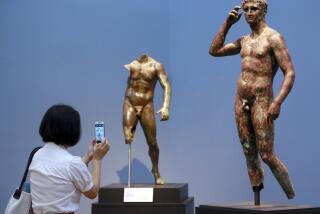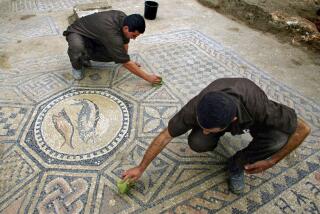Byzantine Mosaics Belong to Cyprus, Judge Rules
- Share via
INDIANAPOLIS — A U.S. District Court judge here ruled Thursday that the Greek Orthodox Church of Cyprus is the rightful owner of four rare Byzantine Christian mosaics that were chiseled from an ancient Cypriot church.
In a lengthy order, Judge James Noland rejected the claims of Indiana art dealer Peg L. Goldberg, who asserted that she bought them in good faith last year for $1 million.
The mosaics, dating from the 6th Century, are among the few remaining examples of Byzantine Christian art.
Scholars and art experts rate them as the third most important examples from that period. Each measuring about two feet square, the mosaics represent an angel, Jesus as an adolescent and the apostles James and Mathew.
The decision triggered elation from Cypriot officials in the United States and in the Republic of Cyprus. George Vassiliou, the president of Cyprus, interrupted a large meeting in Nicosia to tell a crowd that the republic had been vindicated by the Indianapolis court.
Michael Kyprianou, the senior counsel of the Republic of Cyprus, said that the verdict reinforced his faith in American justice. He said that he would fly from Washington to Indianapolis today in an attempt to retrieve the mosaics. Lawyers for Goldberg are expected to ask the judge to delay his actions to give the art dealer time to appeal.
The mosaics, documented and studied by Harvard University’s Center for Byzantine Studies, once graced the apse of Panagia Kanakaria, an ancient church located in the village of Lythrankomi in the northern tip of Cyprus. The area has been controlled by Turkish occupation forces since 1974.
The mosaics disappeared after Greek-speaking residents were forced from the village in 1976 by Turkish forces. Goldberg bought them last year from a Turk living in Munich and brought them to Indianapolis.
Goldberg offered the mosaics for sale for $20 million to the J. Paul Getty Museum in Malibu. Marion True, the Getty’s curator of antiquities, notified Cypriot officials of their location and, after Goldberg refused to return them, the Turks filed suit.
Art experts predict that the ruling could become a landmark in the international art trade.
Walter Hopps, former director of the Menil Collection in Houston, called the decision “an extraordinary victory for the church and archeology. The decision will make honest suitors of the world’s great museums and tend to discourage the practices of going through the back door to acquire objects of questionable background.”
Since the 1960s, international concern over the destruction of archeological sites and the looting of art treasures has triggered a movement resulting in international treaties and laws to stem the black market trade.
More to Read
Sign up for Essential California
The most important California stories and recommendations in your inbox every morning.
You may occasionally receive promotional content from the Los Angeles Times.













